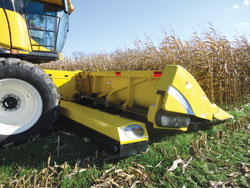 “The idea just popped in my head back in 2006 when we were demonstrating a chopping corn head,” says Jim Straeter of Rochester, Ind. “It occurred to me that since the combine could harvest as well as chop stalks, it could also put those stalks in a nice windrow.”
“The idea just popped in my head back in 2006 when we were demonstrating a chopping corn head,” says Jim Straeter of Rochester, Ind. “It occurred to me that since the combine could harvest as well as chop stalks, it could also put those stalks in a nice windrow.”
After 5 years of designing, building, testing and tweaking, Straeter’s patented “Cornrower™” invention is now on the market.
The Cornrower gathers stalks from under a chopping corn head before they hit the ground, reduces the particle size, and makes a clean windrow of stover directly behind a combine. The rowed stalks are free of dirt and rocks or even snow when there’s a late harvest. The implement runs off the variable speed combine drive, so no additional power source is needed.
During the past two years, Straeter has thoroughly tested and improved his prototype model that was 3 years in the making. “After 5 harvest years I think we’ve got the bugs out,” Straeter says. In optimal conditions, harvest speed is typically 3.5 mph in 200-bu. corn with 20 percent grain moisture and 40 percent stalk moisture. Field speed is less in higher moisture corn, in stalks that are damp or frozen, or if snow is on the ground.
The Cornrower uniformly deposits stover in a straight row under the center of the combine. Cobs and leaf residue land on top as the combine discharges it. Because the Cornrower slices and cuts the stalks, Straeter says they dry down quickly so bales are roughly 20 percent more dense than those done with a conventional chop, rake and bale system.
Straeter says the Cornrower produces “baler-friendly windrows with cleanly cut short stubble that’s easy on pickup tines. Baled stover from the Cornrower can be used in a TMR mixer to produce high quality feed for livestock.” One Indiana farmer added hydrated lime to his Cornrower stover last fall, then chopped it with a forage harvester and packed it in a standard bunker silo with corn silage. Feed trials by Iowa State and the University of Nebraska show that lime treatment increases digestibility and significantly reduces the cost to feed beef cattle. Lime softens the stover and makes the sugars more digestible. Ethanol plants are also looking at bales from the Cornrower because the stalks are clean and dirt-free.
Field tests have shown that baler intake, bale density and bale shape with Cornrower stalks are all improved over conventional chopping and raking.
“My first prototype had a single row of sickle sections mounted on a rotor shaft and that didn’t work too well. I modified that with a single housing and put it on the outside left row of an 8-row corn head. I ran one row at a time and made adjustments until I finally got a configuration I thought would work.”
In the fall of 2009, Straeter built a setup for all 8-rows on a 99C chopping head and used it for the first time on a warm Sunday afternoon. He says he was excited to see a nice uniform windrow and baled those stalks later that afternoon. “We tested those bales for moisture content and dirt and the results were very positive,” Straeter says. “The stover was clean and the bales stored very well without overheating.”
In addition to time, labor and fuel savings, the Cornrower eliminates the need for a stalk shredder, a rake and a tractor to run those implements. Windrows behind the combine can be picked up by any large round baler, large or small square bale, or forage harvester.
Straeter has tested the Cornrower on New Holland CR and Case IH 8010 combines. He says New Holland machines have to be 2008 or newer because they have the stronger header drive. “The Cornrower will work on older CR combines, but the variable speed drive isn’t as strong and belt life is unacceptably short.” Straeter says the rig will work on CIH 7010, 8010 and any of the newer 7000 and 8000 series combines based on the 8010 tests. He expects to test the Cornrower on other combines in the fall of 2012.
Straeter says running the Cornrower takes about 3 gal. more fuel an hour than just a chopping corn head, but overall savings on equipment. The Cornrower is being manufactured by Craig Welding of Mentone, Ind.
Parts will be available from the dealership in Rochester. Straeter hopes to have additional dealers by 2013 and is also looking into teaming up with chopping corn head manufacturers.
1-800-834-9665
Header Attachment Windrows Stalks During Harvest
FARM SHOW Magazine » Header Attachment Windrows Stalks During Harvest
Header Attachment Windrows Stalks During Harvest
